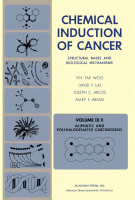Browse content
Table of contents
Actions for selected chapters
- Full text access
- Book chapterNo access
5 - Structure–Activity Relationships
Pages 3-414 - Book chapterNo access
Updating Notes
Pages 415-462 - Book chapterNo access
APPENDIX I - Novel Types of Carcinogens
Pages 463-480 - Book chapterNo access
APPENDIX II - Update to Vol. I: New Developments in Short-Term Tests for Carcinogenicity: Genetic Toxicology Testing
Pages 481-521 - Book chapterNo access
APPENDIX III - Update to Vol. I: New Perspectives in Cancer Research Data Search: Modern Computer-Based Information Systems
Pages 523-532 - Book chapterNo access
APPENDIX IV - Update to Vol. IIA: Metabolic Activation by One-Electron and Two-Electron Oxidation in Aromatic Hydrocarbon Carcinogenesis
Pages 533-569 - Book chapterNo access
Index
Pages 571-598
About the book
Description
Chemical Induction of Cancer: Structural Bases and Biological Mechanisms, Volume IIIB: Aliphatic and Polyhalogenated Carcinogens covers environmentally and occupationally significant carcinogens of industrial origins. The book discusses the structure-activity relationships, metabolism, and environmental significance of the halogenated linear alkanes and alkenes and the halogenated cycloalkanes; and cycloalkene pesticides, biphenyls, and related aromatics. The text also describes the structure-activity relationships, metabolism, and environmental significance of the halogenated phenoxy acids, aromatic ethers, dibenzofurans, and dibenzo-p-dioxins; and ethylene glycol, diethylene glycol, dioxane, and related compounds. The structure-activity relationships, metabolism, and environmental significance of phenols and phenolic compounds; nitroalkanes and nitroalkenes; and acetamide, dimethylcarbamyl chloride, and related compounds thiocarbonyl compounds are also encompassed. The book further tackles the structure-activity relationships, metabolism, and environmental significance if fatty acids, detergents, and other surfactants with oncogenic potential. The text then looks into the effect of chemical reactivity, molecular geometry, and metabolism on carcinogenic activity. Chemists, geneticists, and those involved in cancer research will find the book invaluable.
Chemical Induction of Cancer: Structural Bases and Biological Mechanisms, Volume IIIB: Aliphatic and Polyhalogenated Carcinogens covers environmentally and occupationally significant carcinogens of industrial origins. The book discusses the structure-activity relationships, metabolism, and environmental significance of the halogenated linear alkanes and alkenes and the halogenated cycloalkanes; and cycloalkene pesticides, biphenyls, and related aromatics. The text also describes the structure-activity relationships, metabolism, and environmental significance of the halogenated phenoxy acids, aromatic ethers, dibenzofurans, and dibenzo-p-dioxins; and ethylene glycol, diethylene glycol, dioxane, and related compounds. The structure-activity relationships, metabolism, and environmental significance of phenols and phenolic compounds; nitroalkanes and nitroalkenes; and acetamide, dimethylcarbamyl chloride, and related compounds thiocarbonyl compounds are also encompassed. The book further tackles the structure-activity relationships, metabolism, and environmental significance if fatty acids, detergents, and other surfactants with oncogenic potential. The text then looks into the effect of chemical reactivity, molecular geometry, and metabolism on carcinogenic activity. Chemists, geneticists, and those involved in cancer research will find the book invaluable.
Details
ISBN
978-0-12-059323-1
Language
English
Published
1985
Copyright
Copyright © 1985 Elsevier Inc. All rights reserved.
Imprint
Academic Press
